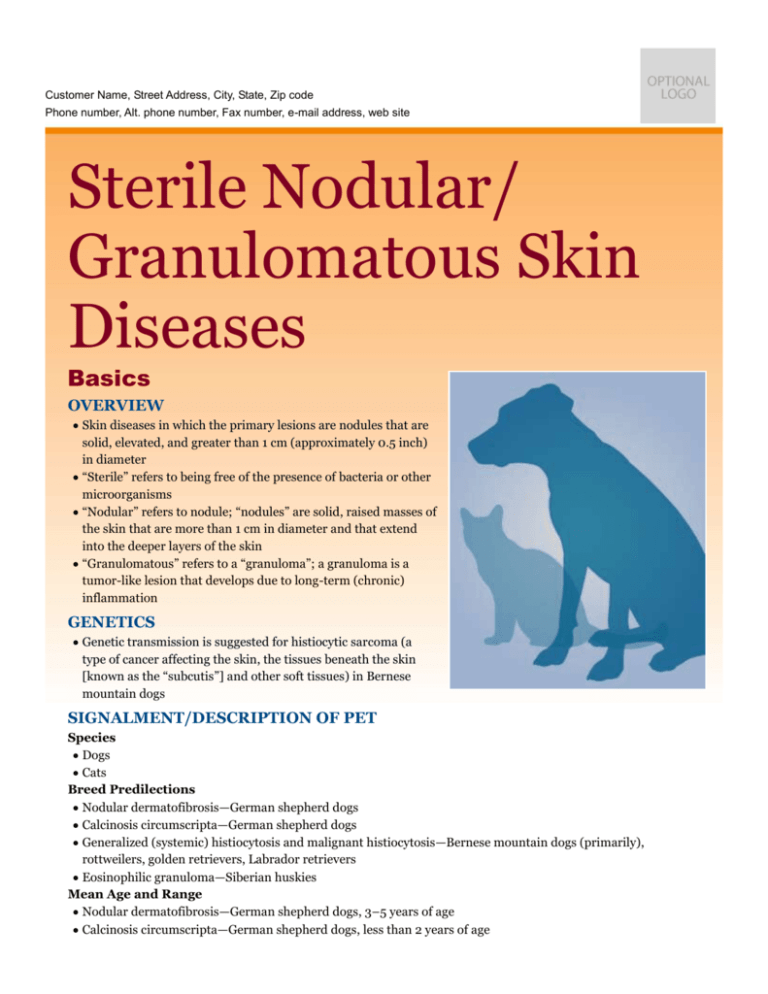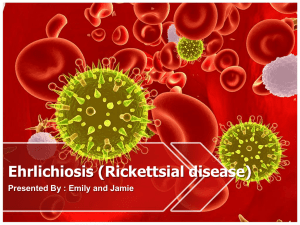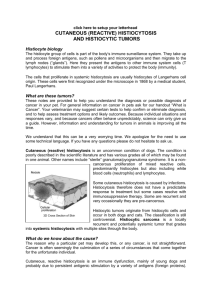sterile_nodular_granulomatous_skin_diseases
advertisement

Customer Name, Street Address, City, State, Zip code Phone number, Alt. phone number, Fax number, e-mail address, web site Sterile Nodular/ Granulomatous Skin Diseases Basics OVERVIEW • Skin diseases in which the primary lesions are nodules that are solid, elevated, and greater than 1 cm (approximately 0.5 inch) in diameter • “Sterile” refers to being free of the presence of bacteria or other microorganisms • “Nodular” refers to nodule; “nodules” are solid, raised masses of the skin that are more than 1 cm in diameter and that extend into the deeper layers of the skin • “Granulomatous” refers to a “granuloma”; a granuloma is a tumor-like lesion that develops due to long-term (chronic) inflammation GENETICS • Genetic transmission is suggested for histiocytic sarcoma (a type of cancer affecting the skin, the tissues beneath the skin [known as the “subcutis”] and other soft tissues) in Bernese mountain dogs SIGNALMENT/DESCRIPTION OF PET Species • Dogs • Cats Breed Predilections • Nodular dermatofibrosis—German shepherd dogs • Calcinosis circumscripta—German shepherd dogs • Generalized (systemic) histiocytosis and malignant histiocytosis—Bernese mountain dogs (primarily), rottweilers, golden retrievers, Labrador retrievers • Eosinophilic granuloma—Siberian huskies Mean Age and Range • Nodular dermatofibrosis—German shepherd dogs, 3–5 years of age • Calcinosis circumscripta—German shepherd dogs, less than 2 years of age • Eosinophilic granuloma—Siberian huskies, less than 3 years of age Predominant Sex • Eosinophilic granuloma—male Siberian huskies SIGNS/OBSERVED CHANGES IN THE PET • Depend on cause • Characterized by single to multiple nodules on the skin or in the tissues under the skin (subcutis) • Nodules may be firm to fluctuant (moveable or wave-like movements) • Lesions may be tender or painful to the pet • Skin over the nodule may be normal to ulcerated CAUSES • Amyloidosis • Foreign body reaction • Spherulocytosis • Idiopathic sterile granuloma and pyogranuloma • Canine eosinophilic granuloma • Calcinosis cutis • Calcinosis circumscripta • Malignant histiocytosis (disseminated histiocytic sarcoma) • Reactive histiocytosis (affecting the skin [cutaneous] or generalized [systemic]) • Sterile nodular panniculitis • Nodular dermatofibrosis • Cutaneous xanthoma RISK FACTORS • Foreign body reaction—induced by exposure to any irritating material (such as concrete dust or fiberglass) • Hair foreign bodies—increased risk for large dogs that rest on hard surfaces • Calcinosis cutis—increased risk with exposure to high doses of steroids in medications or with excessive steroids produced by the adrenal glands (condition known as “hyperadrenocorticism” or “Cushing's syndrome”) • Panniculitis—increased risk with vitamin E–deficient diet • Cutaneous xanthoma—high-fat diet or treats; diabetes mellitus (“sugar diabetes”), or increased levels of lipids (compounds that contain fats or oils) in the blood (known as “hyperlipidemia”) Treatment HEALTH CARE • Most of these disorders can be treated on an outpatient basis • Dogs with calcinosis cutis may need to be hospitalized for generalized bacterial infection (known as “sepsis”) and intense topical therapy • Pets with cancer or metabolic disorders may require hospitalization and supportive care • Dogs in which the nodules have ulcerated or ruptured open will benefit from hydrotherapy to keep the skin and lesions clean ACTIVITY • Normal activity DIET • Pets with xanthomas (soft bumps containing lipids)—low-fat diet and treats SURGERY • Skin biopsy for diagnosis and for tissues for bacterial and fungal cultures • Amyloidosis—if the lesion is solitary, it may be removed surgically • Spherulocytosis—only effective treatment is surgical removal • Foreign body reactions—best treated by removal of the offending substance, if possible • Calcinosis circumscripta—surgical removal is the treatment of choice • Sterile nodular panniculitis—single lesions can be removed surgically Medications Medications presented in this section are intended to provide general information about possible treatment. The treatment for a particular condition may evolve as medical advances are made; therefore, the medications should not be considered as all inclusive • Amyloidosis—no known therapy (unless the lesion is solitary and can be removed surgically) • Idiopathic sterile granuloma and pyogranuloma—prednisone is the first line of therapy; continue steroids for 7– 14 days after complete remission; then taper dose; for cases that are not responsive to steroids, azathioprine or cyclosporine may be tried • Foreign body reactions—best treated by removal of the offending substance, if possible; for hair foreign bodies, the dog should be placed on softer bedding and topical therapy with agents to soften and loosen crusts and scales on the skin (known as “keratolytic agents”) should be initiated; many dogs with hair foreign bodies also have secondary deep bacterial infections that need to be treated with both topical (applied directly to the skin lesions) and systemic (administered by injection or mouth) antibiotics • Canine eosinophilic granuloma—prednisone usually effective • Malignant histiocytosis—no effective long-term treatment; lomustine has been used with some short-term success • Cutaneous or systemic histiocytosis—high-dose steroids, cyclosporine, and chemotherapeutic drugs can result in remission; long-term treatment is usually necessary and recurrences are common • Calcinosis cutis—underlying disease must be controlled, if possible; most cases require antibiotics to control secondary bacterial infections; hydrotherapy (which may be achieved with either a whirlpool bath or by spraying cool water under pressure against the affected skin) and frequent bathing in antibacterial shampoos minimize secondary problems; topical dimethyl sulfoxide (DMSO) is useful (applied to no more than one-third of the body once daily until lesions resolve) • Sterile nodular panniculitis—prednisone is the treatment of choice; administer until lesions regress; then tapered; some dogs remain in long-term remission, but others require prolonged alternate-day therapy; a few cases respond to oral vitamin E; pets that do not respond to these treatments (known as “refractory cases”) my respond to cyclosporine • Nodular dermatofibrosis—skin condition seen in German shepherd dogs; no therapy for most cases, because these dogs usually also have kidney disease or cancer; if cancer involves only one kidney, surgical removal of the affected kidney may be helpful • Cutaneous xanthoma—correction of the underlying diabetes mellitus (sugar diabetes) or correction of the increased lipoprotein content of the blood (lipoproteins are complexes of lipids [compounds that contain fats or oils] and protein; condition known as “hyperlipoproteinemia”) is usually curative • Tetracycline (an antibiotic) and niacinamide can be used as an alternative to steroids in dogs; mainly effective in mild cases Follow-Up Care PATIENT MONITORING • Pets on long-term steroids or other medications to decrease the immune response (immunosuppressive treatment) should have a complete blood count (CBC), blood chemistry screen, urinalysis, and urine culture performed at least every 6 months • Dogs being treated with DMSO for calcinosis cutis should have blood calcium levels checked every 7–14 days for the first month of treatment POSSIBLE COMPLICATIONS • Death from generalized (systemic) amyloidosis, malignant histiocytosis, and nodular dermatofibrosis • Long-term use of steroids or other medications to decrease the immune response (immunosuppressive treatment) may make the pet more susceptible to other skin diseases (such as bacterial and fungal skin infections and demodectic mange); side effects of the medications may cause health problems EXPECTED COURSE AND PROGNOSIS • Depend on cause • Malignant histiocytosis, systemic amyloidosis, nodular dermatofibrosis, and systemic reactive histiocytosis— almost always fatal; survival time for pets with malignant histiocytosis is usually less than 3 months • Prognosis for cutaneous reactive histiocytic disease, sterile nodular panniculitis, sterile pyogranuloma, and other sterile nodular/granulomatous skin diseases is guarded; these diseases require long-term treatment to decrease the immune response (known as “immunosuppressive treatment”) to maintain remission; some pets will not respond to treatment Key Points • Skin diseases in which the primary lesions are nodules that are solid, elevated, and greater than 1 cm (approximately 0.5 inch) in diameter Enter notes here Blackwell's Five-Minute Veterinary Consult: Canine and Feline, Fifth Edition, Larry P. Tilley and Francis W.K. Smith, Jr. © 2011 John Wiley & Sons, Inc.






